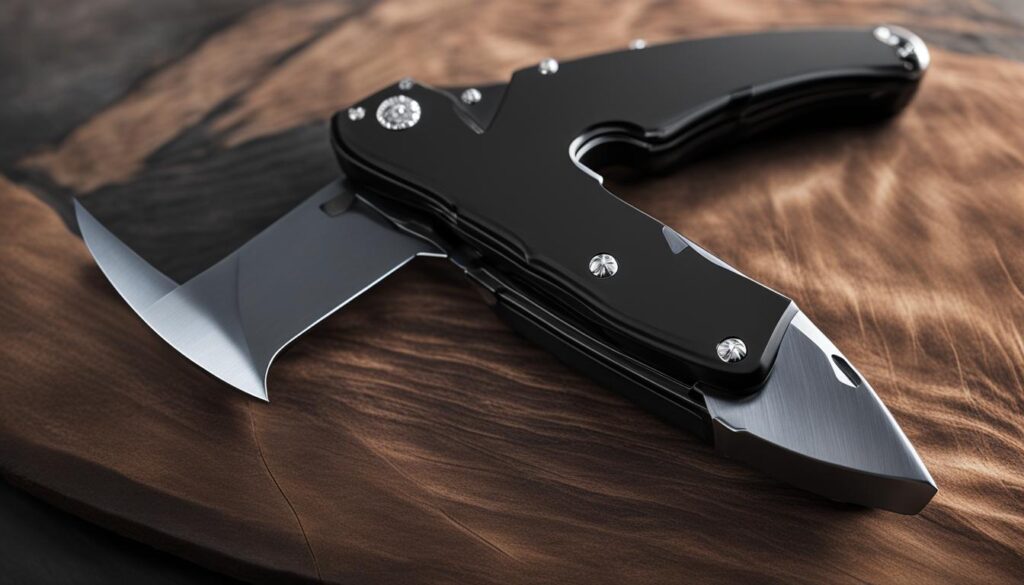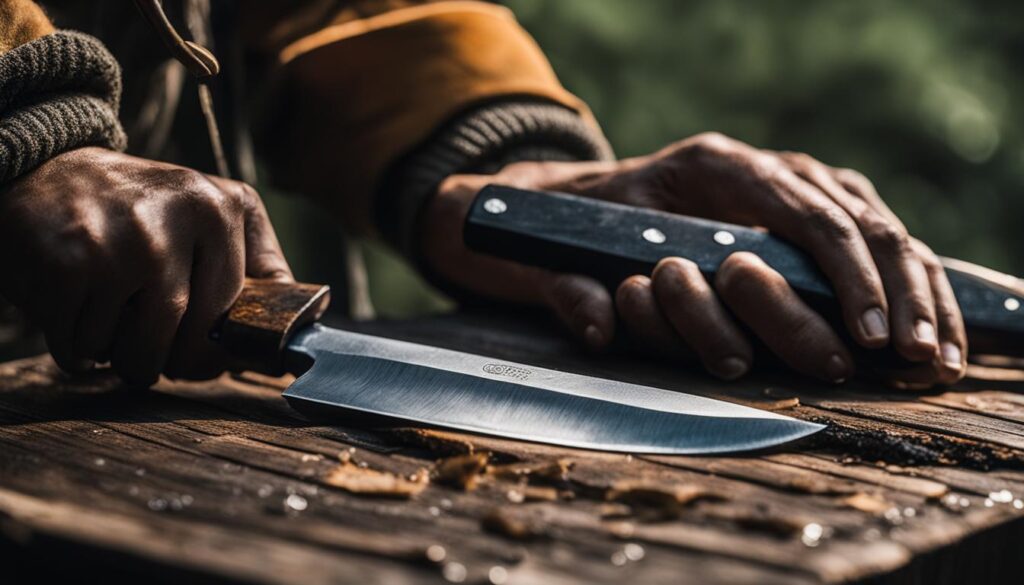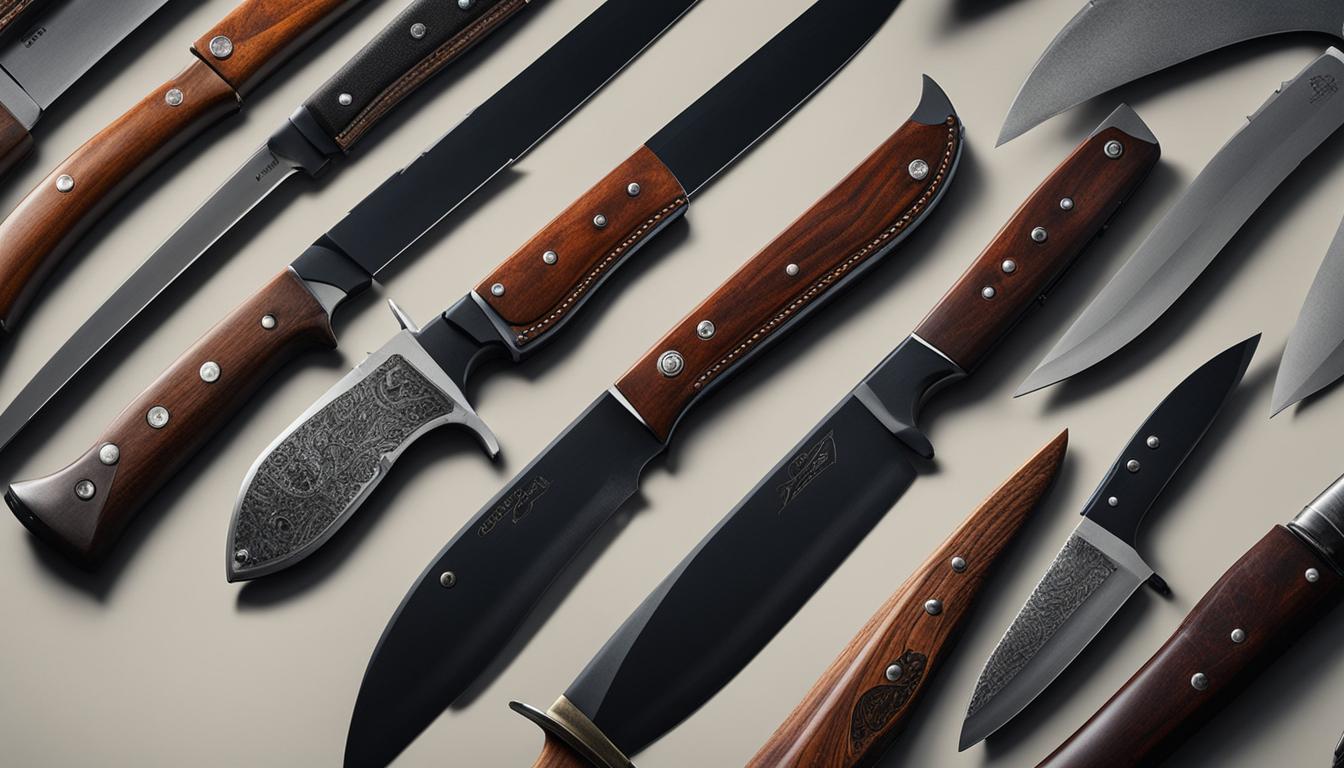As a responsible hunter, it is crucial to understand and adhere to the knife permit requirements and regulations in the United States. Knowing the blade license criteria and the necessary knife permit can ensure that you carry your hunting knife legally and responsibly. In this comprehensive guide, I will provide you with essential information on knife license prerequisites, pocket knife rules, and laws specific to each state, as well as federal regulations that govern the possession and carrying of knives.
Key Takeaways:
- Understanding the knife permit requirements and regulations is essential for legal and responsible knife carrying while hunting.
- Each U.S. state has its own specific pocket knife laws and restrictions, so it’s important to research and familiarize yourself with the regulations in your state and any state you plan to visit.
- Federal laws, such as the Federal Switchblade Act of 1958, regulate the manufacturing, interstate transportation, importation, and sale of switchblade knives, but possession and carrying of switchblade knives may not be restricted in states where they are legal.
- Knowing the different types of pocket knives and their blade shapes can help you choose the right knife for your needs.
- By prioritizing safety and responsible knife handling, you can enjoy hunting while adhering to the necessary permit requirements and regulations.
Types of Pocket Knives and Blade Shapes
When it comes to pocket knives, there are various types and blade shapes to choose from. Understanding these options can help you find the right knife for your needs. Let’s explore the different types and blade shapes of pocket knives:
Folding Knives
Folding knives are the most common type of pocket knife. They feature a pivot mechanism that allows the blade to fold into the handle, making them compact and easy to carry. Folding knives are versatile and come in a variety of sizes and designs.
Fixed Blade Knives
Fixed blade knives have a non-folding blade that is permanently attached to the handle. These knives are typically larger and more robust, making them ideal for heavy-duty tasks. Fixed blade knives are commonly used in hunting, survival, and tactical situations.
Multi-tool Knives
Multi-tool knives combine the functionality of a pocket knife with additional tools, such as screwdrivers, pliers, and saws. These versatile knives are handy for various tasks and are popular among outdoor enthusiasts and handy individuals.
Blade Shapes
The blade shape of a pocket knife determines its cutting characteristics and intended use. Here are some common blade shapes:
- Drop Point: The drop point blade has a convex curve, which makes it durable and versatile for everyday tasks.
- Clip Point: The clip point blade features a concave curve and a thinner tip, making it suitable for precision tasks and piercing.
- Tanto: The tanto blade has a straight edge and a strong point, making it ideal for piercing and heavy-duty tasks.
Understanding the different types of pocket knives and blade shapes can help you make an informed decision when choosing a knife. Whether you need a compact folding knife for everyday carry or a sturdy fixed blade knife for outdoor adventures, there is a knife out there that will suit your needs.
Legal Definition of Pocket Knives
The legal definition of pocket knives can vary across states and at the federal level. It’s important to be aware of the specific laws and regulations concerning pocket knives to ensure compliance and responsible carrying. Factors such as blade length, one-hand opening mechanism, and intent of use may determine how pocket knives are classified and regulated. The legal definitions can be complex and subject to interpretation, so it’s advisable to consult with local authorities or legal experts for clarification.
Understanding the legal definition of pocket knives is essential for responsible knife ownership. By familiarizing yourself with the specific laws of your state, you can avoid potential legal consequences and carry your pocket knife confidently and lawfully.
“Knowing and adhering to the legal definition of pocket knives is crucial for responsible carrying and compliance with laws.”
To provide a clearer understanding of the legal definition of pocket knives, the table below outlines some key factors that may impact their classification:
| Factor | Impact on Classification |
|---|---|
| Blade Length | Determines whether the knife falls under concealed carry or open carry regulations. |
| One-Hand Opening Mechanism | May classify the knife as a switchblade or assisted-opening knife, subject to specific restrictions. |
| Intent of Use | Considered when determining whether the knife is for self-defense or utility purposes. |

Key Takeaways:
- The legal definition of pocket knives varies across states and at the federal level.
- Factors such as blade length, one-hand opening mechanism, and intent of use impact classification.
- Consulting with local authorities or legal experts can provide clarity on specific laws and regulations.
Federal Laws on Pocket Knives
When it comes to pocket knife regulations in the United States, it’s important to understand the federal laws that govern their possession and transportation. One key federal regulation is the Federal Switchblade Act of 1958, which prohibits the manufacturing, interstate transportation, importation, and sale of switchblade knives. However, it’s crucial to note that possession and carrying of switchblade knives are not restricted in states where they are legal. This means that if a state allows switchblade knives, individuals can possess and carry them without violating federal law.
In addition to the Federal Switchblade Act, there are other federal regulations that pertain to pocket knives. The Transportation Security Administration (TSA) has specific guidelines in place for carrying pocket knives on board aircraft. These guidelines restrict the size and features of pocket knives that can be brought on planes. It’s important to comply with these guidelines to ensure a hassle-free travel experience and avoid any potential legal issues.
Furthermore, the General Services Administration (GSA) regulates pocket knife possession and carry on federal property, such as government buildings and courthouses. It’s important to be aware of and adhere to these regulations when entering federal premises to avoid any legal complications.
Comparison of Federal Pocket Knife Regulations
| Regulation | Federal Switchblade Act | TSA Guidelines | GSA Regulations |
|---|---|---|---|
| Scope | Manufacturing, interstate transportation, importation, and sale of switchblade knives | Carrying pocket knives on board aircraft | Pocket knife possession and carry on federal property |
| Restrictions | Prohibited | Size and features limitations | Compliance with specific regulations |
| Applicability | Across all states | Across all states | On federal property |
Understanding the federal laws on pocket knives is essential for responsible and legal carrying. By staying informed and complying with these regulations, individuals can ensure that they are abiding by the law and engaging in responsible knife possession and transportation.
State-specific Pocket Knife Laws and Regulations
When it comes to pocket knife laws, it’s important to remember that regulations can vary significantly from state to state in the United States. To ensure that you are legally carrying and using a pocket knife, it’s essential to be aware of the specific laws and regulations in your own state as well as in any state you plan to visit. Let’s take a closer look at some key aspects of state-specific pocket knife laws:
Knife Possession Regulations
Each state has its own set of regulations regarding pocket knife possession. Factors such as blade length, type of blade, and the intent of use can all play a role in determining the legal status of a pocket knife. Some states may have restrictions on carrying certain types of knives, such as switchblades or knives with automatic opening mechanisms. It’s important to familiarize yourself with the specific possession regulations in your state to ensure compliance.
Knife Carrying Restrictions
In addition to possession regulations, many states also have specific restrictions on carrying pocket knives. These restrictions may include limitations on where you can carry a knife, such as government buildings or schools. Some states may also require a permit or license to carry a concealed knife. Understanding the carrying restrictions in your state is crucial to avoid any legal issues while carrying a pocket knife.
Research and Compliance
Given the complexity and variation of pocket knife laws across states, it is advisable to conduct thorough research on the specific laws and regulations in your state. This may involve consulting local authorities or legal experts to ensure that you are fully informed and compliant. By understanding and abiding by the state-specific pocket knife laws, you can enjoy the benefits of carrying a pocket knife while staying on the right side of the law.
| State | Possession Regulations | Carrying Restrictions |
|---|---|---|
| Texas | No restrictions on pocket knife possession | No restrictions on carrying pocket knives |
| New York | Switchblade knives are prohibited | Concealed carry of certain pocket knives requires a permit |
| California | No restrictions on pocket knife possession | Carrying certain knives in public places is prohibited |
| Florida | No restrictions on pocket knife possession | No restrictions on carrying pocket knives |
Table: State-specific Pocket Knife Laws and Regulations
Safety Tips for Knife Handling
When it comes to knife handling, safety should always be a top priority. Whether you’re an experienced hunter or just starting out, following these knife safety tips will help ensure responsible and accident-free knife use.
Choose the Right Knife
Using the right knife for the task at hand is essential for safe handling. Different knives are designed for specific purposes, so make sure you select the appropriate knife for the job. Using a sharp knife also reduces the risk of accidents, as it requires less force and provides better control.
Always Cut Away from Your Body
One fundamental rule of knife safety is to cut away from your body. By doing so, you minimize the chances of accidentally cutting yourself. When using a knife, keep your fingers and other body parts away from the blade’s path. This simple habit can prevent serious injuries.
Secure Your Knife Properly
When not in use, always secure your knife in a sheath or a dedicated storage case. This prevents accidental cuts and keeps the blade protected. Never leave a knife lying around or toss it into a bag without proper protection.


Be Mindful of the Folding Mechanism
If you’re using a folding knife, ensure that the lock mechanism is functioning properly before use. A faulty lock can cause the blade to close unexpectedly, resulting in injuries. Regularly inspect and maintain the lock on your folding knife to guarantee safe handling.
Work in a Well-Lit Area
Working with a knife in a well-lit area allows you to see what you’re doing clearly, reducing the chances of accidents. Adequate lighting helps you maintain better control and precision while handling the knife. Avoid working in dimly lit or shadowy environments.
“Using the right knife for the task at hand is essential for safe handling.”
By following these knife handling safety tips, you can ensure responsible knife use and reduce the risk of accidents. Always prioritize safety, use the appropriate knife for each task, and be mindful of your surroundings. Remember, responsible knife handling is crucial for both your own safety and the safety of those around you.
Conclusion
Understanding and adhering to knife permit requirements is crucial for responsible and legal knife carrying while hunting. By familiarizing ourselves with the different types of pocket knives, their blade shapes, and the legal definitions surrounding them, we can ensure compliance with state and federal laws.
To avoid any legal complications, it is essential to research and understand the specific knife laws in our own state and any state we plan to visit. This knowledge empowers us to carry knives responsibly and within the boundaries of the law.
By prioritizing safety and responsible knife handling, we can enjoy hunting while adhering to necessary permit requirements and regulations. We must always remember to handle knives with care, choose the right knife for the task at hand, and take measures to prevent accidents. This way, we can engage in legal knife possession and responsible knife carrying.
FAQ
What are the different types of pocket knives and blade shapes?
There are folding knives, fixed blade knives, and multi-tool knives. Blade shapes include drop point, clip point, and tanto.
How do pocket knife laws vary across states?
Pocket knife laws vary across states in terms of blade length, one-hand opening mechanism, and intent of use. It’s important to research the specific laws of your state to ensure legal carrying.
What are the federal laws regarding pocket knives?
Federal laws include the Federal Switchblade Act of 1958, which regulates the manufacturing, interstate transportation, importation, and sale of switchblade knives. The TSA and GSA have specific regulations for carrying pocket knives on airplanes and federal property.
What should I know about state-by-state pocket knife laws?
Each state has its own specific laws and restrictions regarding pocket knife possession, carrying, and usage. It’s important to familiarize yourself with the knife laws of the state you are in or plan to visit to ensure legal and responsible carrying of pocket knives.
What are some safety tips for knife handling?
Always use a sharp knife, cut away from your body, never run with a knife, and secure it in a sheath when not in use. Make sure the lock on a folding knife is working properly and use a knife in a well-lit area to prevent accidents.





